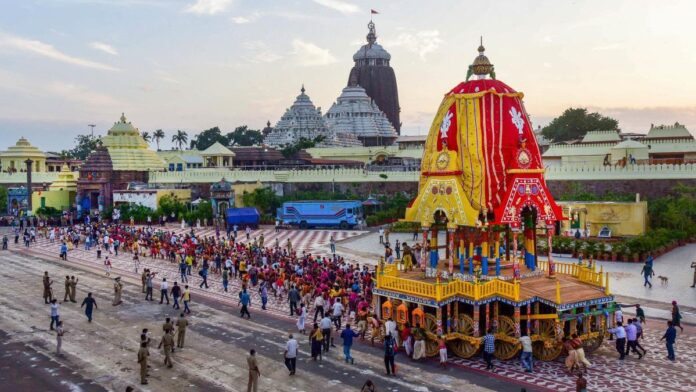By Journey Man
The Jagannath Temple at Puri is one of the most revered Vaishnava sites of worship in India. It is one of the oldest Hindu temples still being used for worship. Its main shrine was built by Anantavarman of the Chodaganga dynasty in the tenth century. The deities within the shrine, however, are believed to be much older and are associated with the great mythical ruler of the Satya-yuga, King Indrayumna, nephew of Lord Ram.
In 1174 AD King Anang Bhim Deo ascended the throne of Orissa. A religious crisis struck the young king when he killed a Brahmin. Traditional tales say that he invested greatly in construction projects for the public to expiate his sins. Among the temples that he built were the ancillary shrines and the walls of the Jagannath temple.
The construction cost him a million and a half measures of gold (half-a-million sterling in 1886) and took fourteen years to complete (in 1198 AD). He organised the order of the temple servitors (Chattanooga) to manage the temple built by his father.
The murtis (idols) of Lord Jagannath and his siblings were revered and worshipped here without interruption until 1568.
In 1568, after defeating the Gajapati ruler Mukunda Deva, General Kalapahad led the victorious army of the Nawab of Bengal, Sultan Suleiman Karani into the temple complex to loot it. The deities had, however, been smuggled out of the Garbha Griha and hidden near Chilika lake. Kalapahad soon found them and set them ablaze.
A devotee had followed the army to the lake and upon their departure managed to retrieve the Brahma (soul) of the deities in some ash. He brought this (hidden inside a mridanga) to the kingdom of Kujang. In the absence of the deities from their home, the Srimandir mourned and no mahaprasad (the 56 food items served to Lord Jagannath) was served.
The Hindu kingdom of Khurda was ruled at this time by Ramachandra Deva I. He brought the Bramha to his kingdom and organised a Nobokoliboro (the ritual of the New Body) to bring the deities back to their temporal abode. The Lord of the Universe thus returned to Puri in 1575 after almost a decade. As an expression of their gratitude, the devotees bestowed Ramachandra Deva I with the name ‘Abhinav Indrayumna’ (Indrayumna incarnate).
Within two decades, Ramachandra Deva I’s authority over Puri and the Temple was recognised even by the Mughal Empire. Raja Mansingh bestowed upon him the title of ‘Gajapati Ruler of Khurda and Superintendent of the Jagannath Temple’.
The Marathas and the British assumed control of the temple complex in 1751 and 1803, respectively. Locally, however, the Rajas of Khurda would retain the trust of the devotees in managing the Temple and its rituals. In 1809 the British East India Company officially returned the charge of the Temple to the Rajas who would retain control till British power itself was uprooted from the Indian subcontinent.
In 1975, the Archeological Survey of India undertook a project to remove the multiple layers of lime plaster to uncover the original designs beneath. The conservation project lasted for 2 decades. The temple, which in the 19th century, recognised by European sailors as the “white pagoda”, now proudly displays the natural colours of the khondalite stone that had been used by Anantavarma to construct the home of the Lord in the 10th century.
How to get there
Odisha is known as the land of Lord Jagannath (literally meaning the Lord of the Universe). Puri, also known as Jagannath Puri, is the headquarters of the Puri district of Odisha, situated on the Bay of Bengal, 60km south of the state capital of Bhubaneswar.
Puri is referred to as one of the holiest sites for Hindus, but for many more, it is also a very lovely and welcoming beach resort. While a visit to Puri is not complete without a visit to the 11th century Puri Jagannath temple, even foreigners (who are not allowed into the temple) can enjoy the town and the fine beaches of the town.
Puri is easily accessible from all parts of India, with daily flights operating to Bhubaneswar, from where a comfortable bus ride can take you to Puri. The new Jagannath Sadak (highway) connects Puri with western and southern Odisha. However, it is better to arrive in this town by train, operating on all main lines from the south and the east. It reaches you directly to Puri and is comfortable as well.
Puri is representative of the huge cultural heritage of Odisha (formerly Orissa), and its Kalinga lineage.
The state has spawned a huge array of Indian cultural treasures, including intricate classical dance forms, music, songs, the written word, and architecture that can match and surpass any in the country and beyond.
Most importantly, though, is its religious heritage, built around this grand temple. It is regarded as one of the char dhams of the Hindu religion, and it is said that no pilgrimage is complete without a visit to and puja at the Puri Jagannath temple.
Puri is one of the many names that have been given to this town. The town has been mentioned variously in old scriptures, such as the Puranas, as Sreekshetra, Sankha Kshetra, Neelāchala, Neelādri, Purusottama Dhāma, Purusottama Kshetra, Purusottama Puri and Jagannath Puri. The word ‘Puri’ is more of a suffix, meaning town or city in Sanskrit. Possibly Puri is a short form for Jagannath Puri or Purusottama Puri.
One can plan a trip around Odisha, based in Puri –the famous Sun Temple of Konark lies 35 km from Puri is a must visit for all.
A god free of religion
Lord Jagannath is the universal God. He is free of caste, creed or religion. He is the symbol of unity and integrity. His universality is evident in that he represents no particular religion, division, social group, region or country.
Believed to be an incarnation of Lord Vishnu, his beauty and glory lies in the way he is treated by his disciples. He is a living god. All the rituals are performed as per the daily routine of a human being. He is offered ‘bhog’ for breakfast, lunch, snacks and dinner. Lord Jagannath also rests every day in the afternoon and the temple doors remain closed while the lord is taking his afternoon nap.
Lord Jagannath is but a reflection of human existence, encompassing all its facets.
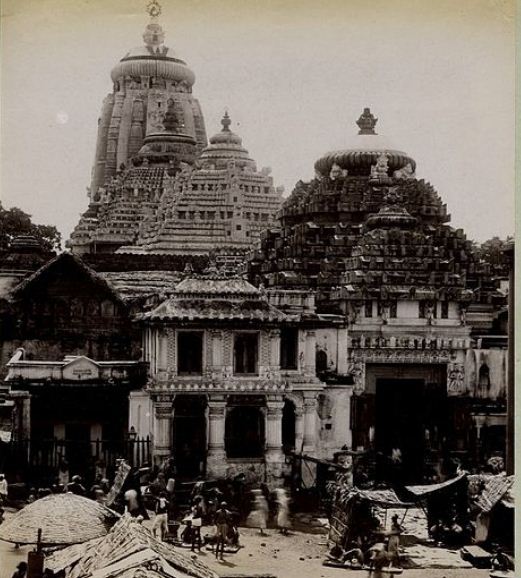

“Just as one gives up worn out clothes and puts on new ones, so does the embodied self give up decrepit bodies and enter new ones,” the Gita has said.
Following the holy Gita, the Lord is also believed to forego his old body to enter a new one in a grand ritual called Nabakalebara. The word Nabakalebara denotes ‘new body’ in Odia language and the deities of the grand temple, Jagannath, Balabhadra, Subhadra and Sudarshan, undergo exactly the same on this great occasion. The new wooden idols are carved and old ones are cremated, following prescribed rites as mentioned in the centuries old scriptures.
This changeover of bodies takes place once every 8 to 18 years, depending on the almanac positions as per the Hindu calendar. It is usually held in a year when the month of Asadha is followed by another Asadha. Accordingly the previous ‘Nabakalebaras’ took place in the years 1969, 1978,1996 and in 2015.
Lord Jagannath is also related with literature, art, politics, culture, science, economics, astrology, Vastu, Tantra, Mantra and Yantra. In short, he is the lifeblood of humanity.
He is full love for his devotees and there is no discrimination. His mercy goes beyond any caste or material qualification. The Lord does not see who is qualified or who is unqualified in the sense of materialistic evaluation. He only accepts the emotions and feelings of his devotees and treats them alike.
Stories of Bhakta Salabega, a Muslim devotee and Dasia Bauri, a low caste weaver who received the divine blessings of the Lord are well known. Since the holy shrine at Puri is opened only to Hindus, legend has it that Lord Jagannath sets out on Rath Yatra every year to bestow his blessings on all his devotees.
Dresses, temples and festivities
Odisha, and Puri to be specific, is brilliant in colours throughout the year. It is brilliant in festivities too, as faith drives men and women in droves to its holy places, especially to Lord Jagannath’s temple, one of the holiest sites in the country. Rituals and systems within the Temple have largely continued unchanged since its construction.
The Lord of the Universe is worshipped here in a very unique manner. He and His siblings are loved and cared for as members of one’s family. Each morning, they are woken up by music and an arati. They are made to change out of their nightclothes and their teeth are brushed. They are given a bath and dressed in time for the morning darshan.
They would be made to change again in time for a light early breakfast (Gopal Ballabh) consisting of fruits, curd and green coconut. A second breakfast (Raj Bhoga) is served at 10 am which is followed up with some Betel nuts to aid digestion. The deities eat an elaborate lunch (Madhyana Dhupa) at 1 pm. In 1910, this mid-day meal consisted of 435 dishes. A feast fit for divinity.
Every heavy meal must be followed by a short siesta and the deities are no exception. Cots are brought into the sanctum sanctorum and the gods are left to slumber in peace. By 6 in the evening, the deities are awoken for an evening snack (Sandhya Dhupa) and darshan. Soon after, they are dressed for the Chandana Lagi, the application of the cooling sandalwood paste and get ready for the evening. The deities eat a late dinner (Badasinghar Bhoga) at 10:30 pm. Their cots are exchanged for substantially more comfortable couches in time for bed.
A sevak (the temple servitor) lulls them to sleep with a recitation of the Gita Govinda (a 12th-century poem by the poet Jayadeva) accompanied by the veena (a chordophone). The Lord of the Universe and his siblings are left to slumber in bliss till the next morning.
Nabakalebara festival
The Nabakalebara rituals are performed in a year when the full moon occurs twice in a month of Asada (Joda Asada). As per the Hindu calendar, it falls in the month from June to July.
This period is called Adhimasa or Malamasa. This Adhimasa or Malamasa occurs once every 8 or 12 or 19 years. That year is considered the most auspicious year for the rebirth of deities.
Most time Joda Adhimasa falls in a 19-year interval. In some cases, it falls under an 8 year or 12-year interval.
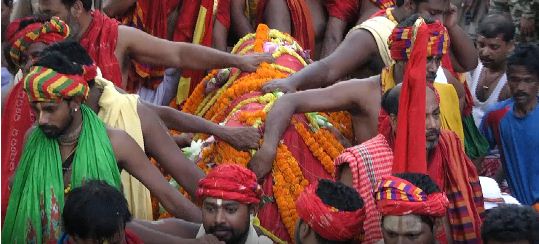

The last Nabakalebara celebration started, as said before, with the BanaJaga yatra on March 29, 2015. It was completed at midnight on June 15, 2015. It is celebrated after a 19-year interval. As per Jagannath Sanskruti researchers and historians, the exact starting year is not clear.
The Nabakalebara rituals of Lord Jagannath are more than 400 years old. It is not clear whether 500 years of this ritual was celebrated or not.
Let us go through a regular calendar year. Let us see the important actions that are carried out each month and each day in the temple. Interestingly, the deities are treated as humans are, being provided with adequate regal attire, regal food and much more. These are probably the only deities in the country and in the Hindu mythology that are taken to visit relatives each year and given restful holidays as well.
Suna Besha
The Shree Jagannath Temple Administration, Puri, says that Raj Besha, or Rajadhiraj Besha, is the golden shringar of Shree Jagannath Mahaprabhu. These are special golden attires, and they are put on five special days: Pousha Purnima, Dola Purnima, Ashadha Shukla Ekadasi (on the chariot) and Kartika Purnima.
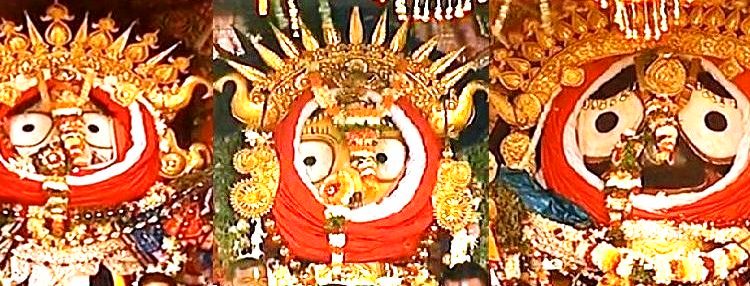

Other than the dress on the chariot, the rest of the dresses are put on in the temple, on the Ratana Simhasan. This is a very old tradition, coming down from 1232. It is said that Anaga Vima Dev started this tradition, and the gold ornaments used during Besha weigh over a quintal.
Patitapabana Bana
This is the pennant hoisted on the Nilachakra of Shree Jagannath Temple. The flag itself is said to redeem the faith of devotees. Faith says that witnessing this flag is synonymous with the darshan of Shree Jagannath Mahaprabhu.
The significance of the flag was probably initiated by the belief that the Lord belongs to all faiths castes and sects. Lord Jagannath is ensconced in the temple and millions of devotees visit it regularly. However, not many are privileged to enter the temple premises due to various reasons. The Patitapabana Bana is meant for such people who would otherwise miss out on the opportunity of his/her worship.
The holy character of the flag itself is evident from the fact that its raising on atop the temple, its tying to the pole and its unfurling is among the 36 major rituals or sevas for the Lord Jagannath. The pole to which this flag is tied is attached to the Nilachakra. This act is carried out every day by a special group of sevayats.
There are now eight families of such sevayats in Puri who hold the exclusive rights to climb to the crown of the shrine.
Even the climb, which has to be practised hard and diligently, is in an unusual manner. Unlike normal climbers, the sevayat has to climb with his back to the wall, with his two outstretched legs on two raised parts of the wall. It is a breathtaking act that takes around 20 minutes. Shree Gundicha Temple.
Mythology terms this as the birthplace of Shree Jagannath Mahaprabhu. During the car festival (Ratha Yatra) the deities are brought to this place and stay here for seven days.
Interestingly, the temple remains empty for most of the year. The deities, Jagannath, his brother Balabhadra and sister Subhadra occupy this temple for seven full days (total 9 days including the start and concluding day of Ratha Yatra) every year.
The temple is about 3 km from the Srimandira, or the main temple of Jagannath.
The distance is the length of the Bada Danda (Grand Avenue) which is the pathway for the Rath Yatra. The temples are at two ends of this road. Earlier there used to be a river crossing the path of the yatra.
The Gundicha Temple is also known as the Garden House of Jagannath. The temple is surrounded by a beautiful garden that lies within the walled compound of the temple.
Made of light-grey sandstone, it signifies the typical Kalinga temple architecture in the Deula style. Within the compound the complex has four structures: viman (the tower, containing the sanctum), jagamohana (assembly hall), nata-mandapa (festival hall) and bhoga-mandapa (hall of offerings). There is also a kitchen.
There is a platform at this temple as well, called Ratnavedi, on which the deities are placed during the annual festivities.
While the temple is empty during the rest of the year, tourists can enter it after paying an entry fee. Even foreigners, who are not allowed entry to the main temple, can visit this temple during this period.
Chandan Yatra
Chandan Yatra also known as Gandhalepana yatra, lasts for 42 days and is the longest festival of the Jagannath temple. Chandan Yatra means sandalwood voyage in Sanskrit and starts on the auspicious Akshaya Tritiya.
As per tradition, Shree Lokanath, Jameswar, Markandeswar, Nilakantheswar and Kapalamochan, astride their respective vahanas join the procession with Madanmohan, representative deity of Shree Jagannath Mahaprabhu. Also present are Shreedevi and Bhudevi.
This yatra is observed in two parts, the Bahara Chandana and Bhitara Chandana.
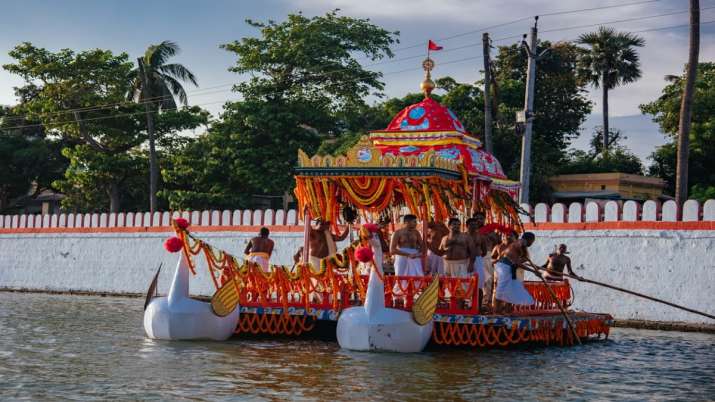

The first starts on the day of Akshaya Tritiya and continues for 21 days. This is an important occasion, as the construction of the chariots for the main Rath Yatra festival starts on Akshaya Tritiya.
During these first 21 days, representative idols of the main deities of the Jagannath temple are taken in a procession from the Singhadwara or the main gate of the Jagannath temple to the Narendra Tirtha tank.
Along with the procession also are five Shiva Lingas, known as the Pancha Pandavas. Following rituals and puja, the deities are placed on elaborately decorated boats for an evening cruise of the tank.
After the first 21 days, the Bhitara Chandana. They comprise rituals inside the temple. There are no daily cruises, but the playful ride happens on four occasions: Amavasya, the full moon night, on the Shashti and the Ekadashi.
Labanikhia Niti
This has to do with the Krishna avatar of Vishnu. Following Janmashtami, or the birthday of Lord Krishna, Madanmohan, Rama and Krishna are carried to the Labanikhia Mandap. Here women from Mahaboi families take part in the rituals.
COVID19 GUIDELINES
- The Lord Jagannath temple in Odisha’s Puri has been reopened for devotees with strict adherence to Covid-19 norms. With the steep rise in Covid-19 cases in Odisha, the Jagannath temple remained closed for devotees from January 10 to January 31. However, the Chhatisha Nijog, at its meeting held on January 28, had decided to reopen the temple for the public following protest by local traders,Who depend on the temple for their livelihood.
- The Shree Jagannath Temple Administration (SJTA) has issued the Standard Operating Procedure (SOP) to ensure devotees have smooth darshan of lords. Devotees have been allowed to enter into the temple from 6 am. The public darshan will continue till 9 pm on all days when the temple will be open for public darshan.
- However, it will remain closed to the public on all Sundays for sanitation activities as a measure to contain the spread of Covid-19 disease.
- As per the SOP, all devotees will be required to bring their photo ID card along with a final certificate for Covid-19 vaccination (of having taken two doses) or Covid-19 negative certificate (RT-PCR) of testing done within 96 hours prior to the visit to the temple.
- Meanwhile, the temple administration has set up a camp for administering precaution dose to Sevayats in the age group of 18 to 60 years.
SOME OF THE ARCHITECTURAL FEATS OF THE TEMPLE
- The main temple is constructed in such a way that no shadow of the temple falls on the ground at any time of the day.
- The Nilachakra Or the Blue wheel perched on top of the temple is made of eight metals or ashtadhatu. It is believed that if you see the Nilachakra it is as good as seeing the Lord himself.
- The flag or the Patitapabana flows in the opposite direction of the wind and is changed every day at sunset and is changed every day. The feet of changing the flag rests with a family appointed by the King. They have been doing this ritual for over 800 years, climbing 165 meters, bare feet without any support.
- The Mahaprasad or the offering to the Lord is prepared on fire lit by wood charcoal and rice and vegetables, cereals etc. are put in earthen pots and placed on the fire one on top of the other. The pot on the top cooks first.
- The Aruna stambha- the 33 ft monolith structure pillar in front of the Singhadwar or the main entrance of the temple was originally located at the Sun Temple, Konark.
- Another unique feature of the temple is that the idols of the holy trinity are carved out of wood rather than stone or metal idols. They are also the only deity with the trappings of mortality.

